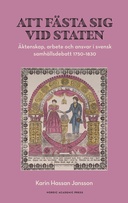Explore

The expression ""to attach oneself to the state"" is a paraphrase for entering into marriage: when a man married, he was also considered to attach himself to the state and become a cog in a larger context. Marriage was seen at the end of the 18th century as a foundation for social order. But what was behind that perception and how were matters of marriage discussed?
In parliament, newspapers, pamphlets and advice literature, writers and other debaters laid out the text of why marriage was so important and how spouses should live their lives to benefit the common good. The falcon, the tyrant and the slipper were, along with government-loving and flamboyant women, some of the figures that appeared. The characters served as deterrent examples and contributed to shaping the norms about gender, work, responsibility that characterized Sweden around the turn of the 1800s.
This book is included in DOAB.
Why read this book? Have your say.
You must be logged in to comment.
Rights Information
Are you the author or publisher of this work? If so, you can claim it as yours by registering as an Unglue.it rights holder.Downloads
This work has been downloaded 24 times via unglue.it ebook links.
- 12 - pdf (CC BY-NC-ND) at Unglue.it.
Keywords
- Age of Revolution
- gender
- Marriage
- Masculinity
- Sattelzeit
- separate spheres
- thema EDItEUR::3 Time period qualifiers::3M c 1500 onwards to present day::3MN 19th century, c 1800 to c 1899
- thema EDItEUR::D Biography, Literature and Literary studies::DB Ancient, classical and medieval texts
- thema EDItEUR::J Society and Social Sciences::JB Society and culture: general::JBS Social groups, communities and identities::JBSF Gender studies, gender groups
- thema EDItEUR::N History and Archaeology::NH History
- thema EDItEUR::N History and Archaeology::NH History::NHT History: specific events and topics::NHTB Social and cultural history
Links
DOI: 10.21525/kriterium.61web: http://www.kriterium.se/site/books/m/10.21525/kriterium.61/
Editions



